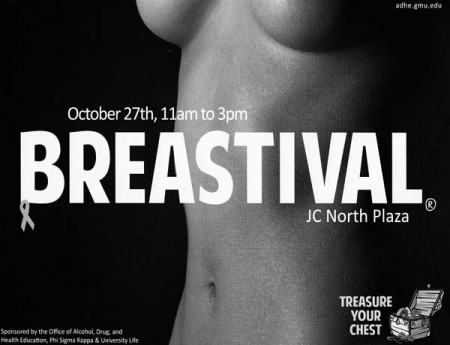
Every October, the Office of Alcohol, Drug and Health Education hosts Breastival, an event which aims to educate students about breast cancer awareness with food, activities and prizes from various vendors and booths.
This year, Breastival will be held on Thursday from 11 a.m. to 3 p.m. at the Johnson Center North Plaza. It will be free and open to the public.
In previous years, there have been popular games such as “Pin the Nipple on the Boob,” “Guess How Many Gumballs This Bra Can Hold,” “Breast of Show” and “Breast Fact Jeopardy.”
As part of Breast Cancer Awareness Month, students learn about early detection and the warning signs of the deadly disease. They also learn how to promote awareness and healthy lifestyle habits for the future.
Did You Know?
•About one in eight American women will develop invasive breast cancer sometime during their lives.
•Currently, there are about 2.6 million breast cancer survivors in the U.S.
•A woman’s risk of breast cancer doubles if she has a first-degree relative who has been diagnosed with breast cancer. Nevertheless, about 75 percent of diagnosed breast cancer cases are not hereditary.
•Besides lung cancer, breast cancer death rates are higher than any other cancer for women in the U.S.
•Although breast cancer in men is rare, a man’s lifetime risk of developing it is one in 1,000.
How to Conduct a Breast Self-Exam
Even though it might seem weird, doing a breast exam on yourself is an important part of early detection, especially if you have not started getting mammograms. If done monthly, it might save your life.
Standing Up:1. In a well-lit room, stand undressed from the waist up in front of a mirror. Relax your arms by your sides and look at your breasts. Make sure to pay attention to any changes in the size, shape or color of your breasts, along with looking for any skin dimpling, puckering or sores. Check your nipples for discharge.2. Put your hands on your hips and press down firmly so that your chest muscles tighten. Turn to each side and inspect the outer part of your breasts.3. Bend over while rolling your shoulders and elbows forward so that your chest muscles tighten again. Look for any changes in the contour of your breasts.4. Raise your arms above your head and inspect the skin border underneath your breasts.
Lying down:1. Place a pillow under your right shoulder and put your right hand behind your head. Place your left hand on the top of your right breast.2. Imagine your breast as a clock. Use your index and middle finger to move around the clock in small circular motions, starting at 12. Make sure to keep your fingers flat and continue to move 1 inch inward after each clock rotation until you’ve felt your entire breast. 3. Repeat with your left breast. If you feel any lumps or are concerned with the texture, color, size or shape of your breasts, contact your doctor immediately.






Comments